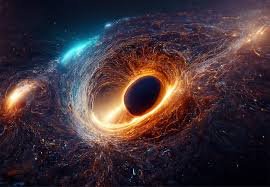
Context
- Astronomers have made a ground-breaking discovery, they have seen an odd object in space descending into the enigmatic “Mass Gap” that surrounds a black hole.
- This mysterious occurrence calls into question what we currently know about astrophysics and raises fascinating questions about the nature of objects that dare to explore this uncharted area of space.
- By examining the ramifications of this peculiar occurrence, researchers hope to gain fresh perspectives on the behavior and dynamics of black holes, expanding our understanding of the universe.
What is Black Hole?
- A cosmic entity with an immensely powerful gravitational force, a black hole prevents anything, including light, from escaping due to its mass being compressed into an incredibly compact volume.
- NASA illustrates this by noting that the mass of a black hole is so substantial that 20 suns could fit within a 16-kilometer diameter sphere.
- The resulting gravitational field distorts space-time and significantly alters the laws of physics in the surrounding area.
About the “Mass Gap”
- To detect and explore these cosmic phenomena, astronomers must depend on indirect observations, like gravitational effects on nearby objects.
- Within a unique mass range between neutron stars and traditional black holes lies the intriguing “Black Hole Mass Gap.” Neutron stars, remnants of massive star collapses, have masses up to three times that of the sun.
- In contrast, traditional black holes form with masses approximately five times that of the sun. Scientists intensively study the mysterious space in between, termed the Mass Gap, seeking to unveil the true nature of celestial objects residing there.
- The phrase “invisible to the eyes” underscores the exceptional nature of black holes. Their gravitational strength is so profound that light cannot escape, rendering them opaque to human eyes and telescopes.
About Mass
- Supermassive black holes have masses that range from millions to billions of times that of the sun.
- Small black holes have masses that range from 5 to 20 times that of the sun.
How do neutron stars work?
• Origin: Following a supernova explosion, a star undergoes a violent death, giving rise to neutron stars.
• Density: With a diameter of 20 km, they are incredibly dense celestial bodies that hold twice the mass of the sun.
• Magnetic fields: Compared to Earth’s magnetic field of 0.5 gauss, they have enormous magnetic fields of about 1012 gauss.
Current Events
Comparison to Black Hole:
- Neutron stars and black holes are both formed when a star explodes violently during a supernova.
- Blackholes have a mass far greater than that of neutron stars.
- In comparison to black holes, neutron stars are noticeably brighter.
- Neutron stars are the densest solid matter in space, although black holes are not solid objects.
- Black holes also trap all light that passes within their vicinity, whereas neutron stars do not.
For Further Information Read this article
FAQ
- What is the Black Hole Mass Gap?
- The Black Hole Mass Gap refers to the range of masses between neutron stars and traditional black holes, where the exact nature of celestial objects has been a topic of scientific interest.
- How is the Black Hole Mass Gap different from other types of black holes?
- The Mass Gap represents an intermediate range of masses not covered by neutron stars or traditional black holes, challenging previous astrophysical categorizations.
- Why is it challenging to observe objects within the Mass Gap?
- Objects within the Mass Gap, including potential intermediate-mass black holes, are challenging to observe directly due to their elusive nature and the fact that black holes do not emit light.
- What recent discoveries have been made regarding the Black Hole Mass Gap?
- Recent astronomical observations have hinted at the existence of objects within the Mass Gap, filling a crucial gap in our understanding of black hole formation and evolution.
- How do scientists detect black holes in the Mass Gap?
- Scientists often rely on indirect observations, such as gravitational effects on nearby objects or phenomena, to infer the presence of black holes within the Mass Gap.
- What are the implications of discovering objects in the Black Hole Mass Gap?
- Discoveries within the Mass Gap provide valuable insights into the diversity of black hole formation mechanisms, shedding light on the complex processes governing the life cycles of these cosmic entities.
- Can black holes in the Mass Gap have any observable effects on their surroundings?
-
- Yes, the gravitational influence of black holes within the Mass Gap can affect nearby stars and gas, leading to observable phenomena that astronomers use to infer their existence.
-
- Are there any theories explaining how black holes in the Mass Gap are formed?
-
- Various theories exist, including the possibility that intermediate-mass black holes are formed through the merging of smaller black holes or by the direct collapse of massive stars.
-
Hi there, I found your website by way of Google at the same time ass looking for a
comparable topic, your site got here up, it looks good. I’ve bookmarked it in my google bookmarks.
Hi there, just turned into aware of your weblog via Google,
and located that it’s really informative. I am gonna be careful for brussels.
I’ll be grateful should you proceed this in future.
A lot of people willl probably be benefited from your writing.
Cheers! https://Zeleniymis.Com.ua/
Thank you for your sharing. I am worried that I lack creative ideas. It is your article that makes me full of hope. Thank you. But, I have a question, can you help me?
thank you for your comment.if you have any doduts and question you can write it down here.
Thanks for sharing. I read many of your blog posts, cool, your blog is very good.